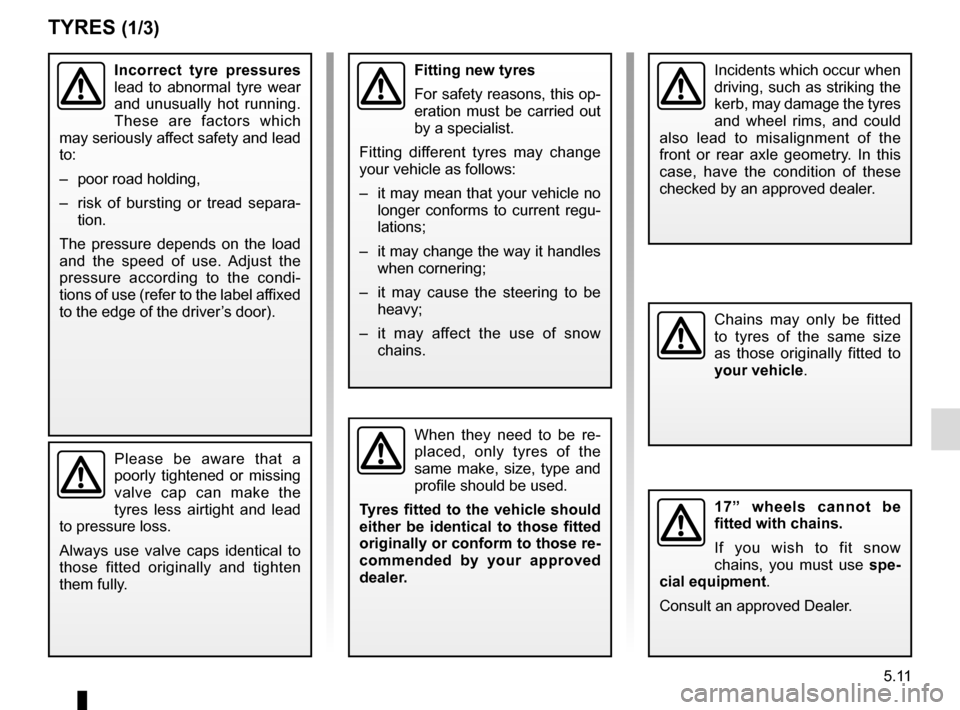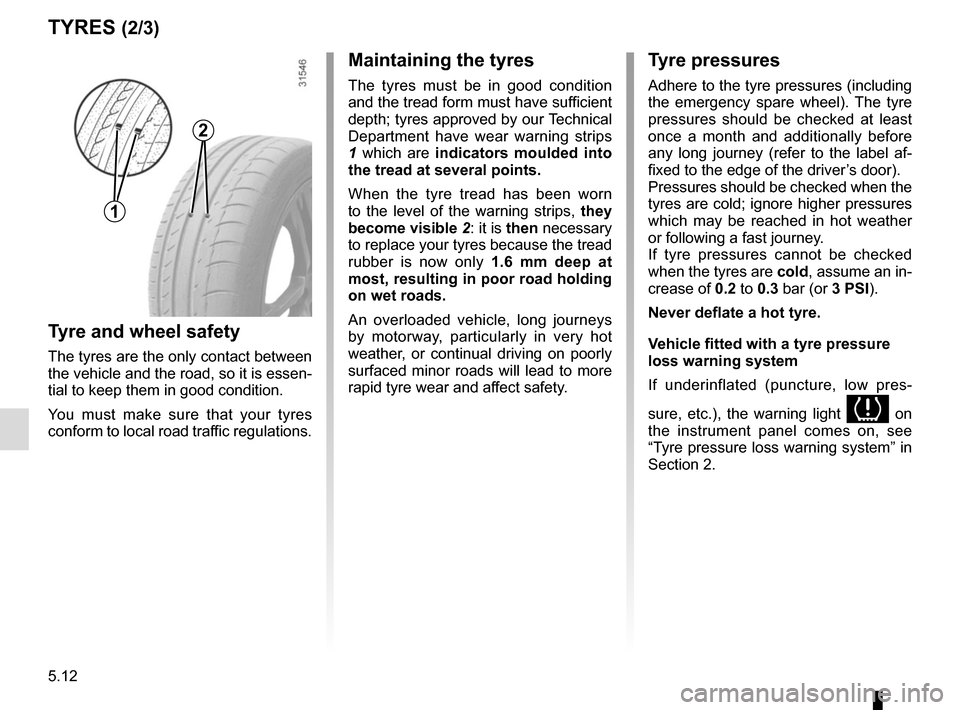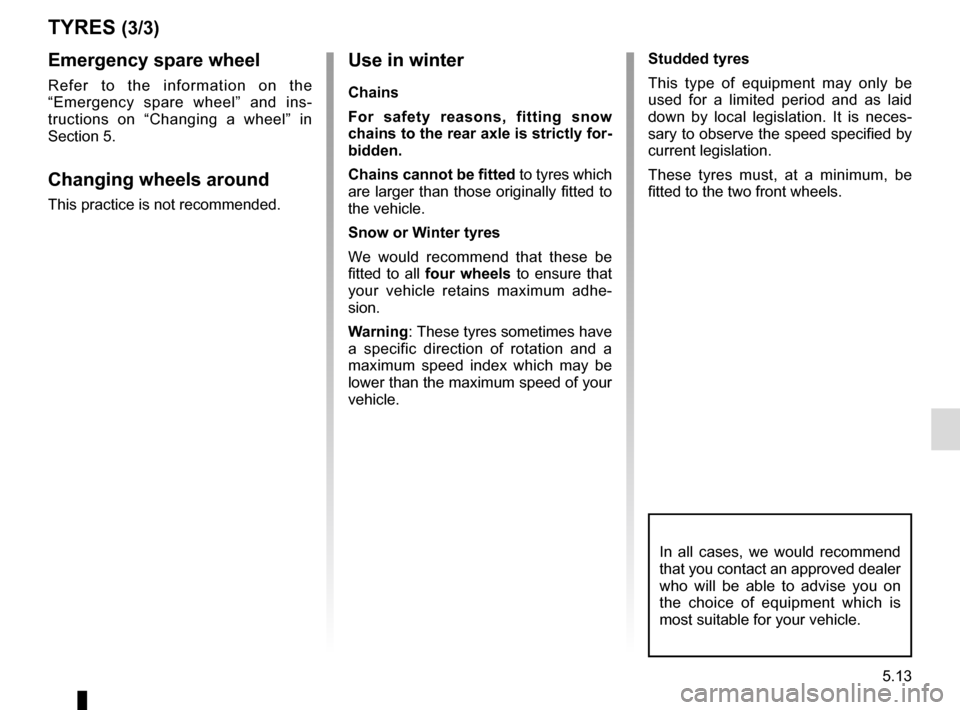Page 228 of 292
5.8
TOOLS (2/2)/TRIMS
Trim 9
Remove the wheel trim using hubcap
tool 5 (located in the tool kit) by fit-
ting the hook into one of the openings
around the edge of the wheel trim.
To refit it, align it with valve 10.
Push the retaining hooks in fully, start-
ing with side A near the valve, followed
by B and C, finishing at D opposite the
valve.
Trim 11
Remove using hubcap tool 5 (located in
the tool kit) by engaging the hook in the
opening near the edge of the trim.
To refit, position the five trim attach-
ments facing the five wheel attach-
ments and press hard in the middle of
the trim to clip it to the wheel.
A
BC
D
10
55
5
9
11
Page 229 of 292

5.9
CHANGING A WHEEL (1/2)
Switch on the hazard warn-
ing lights.
Keep the vehicle away from
traffic and on a level surface
where it will not slip.
Apply the hand brake and engage a
gear (first or reverse, or P for auto-
matic transmissions).
Ask all the passengers to leave the
vehicle and keep them away from
traffic.
To prevent any risk of injury
or damage to the vehicle,
only crank the jack until the
wheel you are replacing is
a maximum of 3 centimetres off the
ground.
If the vehicle is parked on
the hard shoulder, you must
warn other road users of
your vehicle’s presence
with a warning triangle or with other
devices as per the legislation apply-
ing to the country you are in.
If you have a puncture, re-
place the wheel as soon as
possible.
A tyre which has been punc-
tured should always be inspected
(and repaired, where possible) by a
specialist.
Do not leave the tools un-
secured inside the vehicle
as they may come loose
under braking. After use,
check that all the tools are correctly
clipped into the tool kit, then position
it correctly in its housing: there is a
risk of injury.
The jack is designed for wheel
changing purposes only. Under no
circumstances should it be used for
carrying out repairs underneath the
vehicle or to gain access to the un-
derside of the vehicle.
Page 230 of 292
5.10
CHANGING A WHEEL (2/2)
Loosen the wheel nuts and remove the
wheel.
Fit the emergency spare wheel in place
on the central hub.
Tighten the nuts and lower the jack.
With the wheels on the ground, tighten
the nuts as fully as possible and check
the tightness as soon as possible (tight-
ening torque 160 Nm).
Position the trim.
Anti-theft bolt
If you use anti-theft bolts, fit these
nearest the valve (otherwise it may
not be possible to fit the wheel trim).
1
Remove the wheel trim (refer to the in-
formation on “Wheel trims” in Section 5).
Use the wheelbrace 1 to slacken off the
wheel bolts. Position it so as to be able
to push from above.
3
Insert the jack 2 horizontally; the jack
head pin 3 should line up with the hole
in the lower part of the bodywork near-
est the wheel concerned.
Begin to crank the jack so that the base-
plate is correctly positioned (it should
be underneath the vehicle and aligned
with the jack head).
2
Page 231 of 292

5.11
TYRES (1/3)
When they need to be re-
placed, only tyres of the
same make, size, type and
profile should be used.
Tyres fitted to the vehicle should
either be identical to those fitted
originally or conform to those re-
commended by your approved
dealer.
Incidents which occur when
driving, such as striking the
kerb, may damage the tyres
and wheel rims, and could
also lead to misalignment of the
front or rear axle geometry. In this
case, have the condition of these
checked by an approved dealer.Incorrect tyre pressures
lead to abnormal tyre wear
and unusually hot running.
These are factors which
may seriously affect safety and lead
to:
– poor road holding,
– risk of bursting or tread separa- tion.
The pressure depends on the load
and the speed of use. Adjust the
pressure according to the condi-
tions of use (refer to the label affixed
to the edge of the driver’s door).
Please be aware that a
poorly tightened or missing
valve cap can make the
tyres less airtight and lead
to pressure loss.
Always use valve caps identical to
those fitted originally and tighten
them fully.
Fitting new tyres
For safety reasons, this op-
eration must be carried out
by a specialist.
Fitting different tyres may change
your vehicle as follows:
– it may mean that your vehicle no longer conforms to current regu-
lations;
– it may change the way it handles when cornering;
– it may cause the steering to be heavy;
– it may affect the use of snow chains.
Chains may only be fitted
to tyres of the same size
as those originally fitted to
your vehicle.
17” wheels cannot be
fitted with chains.
If you wish to fit snow
chains, you must use spe-
cial equipment.
Consult an approved Dealer.
Page 232 of 292

5.12
TYRES (2/3)
1
2
Maintaining the tyres
The tyres must be in good condition
and the tread form must have sufficient
depth; tyres approved by our Technical
Department have wear warning strips
1 which are indicators moulded into
the tread at several points.
When the tyre tread has been worn
to the level of the warning strips, they
become visible 2: it is then necessary
to replace your tyres because the tread
rubber is now only 1.6 mm deep at
most, resulting in poor road holding
on wet roads.
An overloaded vehicle, long journeys
by motorway, particularly in very hot
weather, or continual driving on poorly
surfaced minor roads will lead to more
rapid tyre wear and affect safety.
Tyre and wheel safety
The tyres are the only contact between
the vehicle and the road, so it is essen-
tial to keep them in good condition.
You must make sure that your tyres
conform to local road traffic regulations.
Tyre pressures
Adhere to the tyre pressures (including
the emergency spare wheel). The tyre
pressures should be checked at least
once a month and additionally before
any long journey (refer to the label af-
fixed to the edge of the driver’s door).
Pressures should be checked when the
tyres are cold; ignore higher pressures
which may be reached in hot weather
or following a fast journey.
If tyre pressures cannot be checked
when the tyres are cold, assume an in-
crease of 0.2 to 0.3 bar (or 3 PSI).
Never deflate a hot tyre.
Vehicle fitted with a tyre pressure
loss warning system
If underinflated (puncture, low pres-
sure, etc.), the warning light
� on
the instrument panel comes on, see
“Tyre pressure loss warning system” in
Section 2.
Page 233 of 292

5.13
Use in winter
Chains
For safety reasons, fitting snow
chains to the rear axle is strictly for-
bidden.
Chains cannot be fitted to tyres which
are larger than those originally fitted to
the vehicle.
Snow or Winter tyres
We would recommend that these be
fitted to all four wheels to ensure that
your vehicle retains maximum adhe-
sion.
Warning : These tyres sometimes have
a specific direction of rotation and a
maximum speed index which may be
lower than the maximum speed of your
vehicle.
TYRES (3/3)
Studded tyres
This type of equipment may only be
used for a limited period and as laid
down by local legislation. It is neces-
sary to observe the speed specified by
current legislation.
These tyres must, at a minimum, be
fitted to the two front wheels.
In all cases, we would recommend
that you contact an approved dealer
who will be able to advise you on
the choice of equipment which is
most suitable for your vehicle.
Emergency spare wheel
Refer to the information on the
“Emergency spare wheel” and ins-
tructions on “Changing a wheel” in
Section 5.
Changing wheels around
This practice is not recommended.
Page 253 of 292

5.33
TOWING: breakdown recovery (1/2)
The steering wheel must be un-
locked and the ignition key must be
in position M (ignition on) to provide
brake lights and hazard warning
lights on the towed vehicle. At night
the vehicle must have its lights on.
Unhitch the trailer, etc., if one is
being towed.
You must observe the towing regu-
lations which apply in the country in
which you are driving: do not exceed
the towing weight for your vehicle.
Contact an approved dealer.
Never use the drive shafts or axles.
These towing points may only be used
for traction: never use them for lifting
the vehicle directly or indirectly.– Use a rigid towing bar.
If a rope or cable is used
(where the law allows this),
the vehicle being towed
must be able to brake.
– A vehicle must not be towed if it is
not fit to be driven.
– Do not accelerate or brake sud- denly when towing, as this may
result in damage being caused to
the vehicle.
– When towing a vehicle, do not exceed 15 mph (25 km/h).
– Do not push the vehicle if the steering column is locked.
When the engine is
stopped, steering and brak-
ing assistance are not op-
erational.
Do not remove the key from
the ignition switch or the
card from the reader during
towing.
Page 254 of 292
5.34
TOWING: breakdown recovery (2/2)
Rear towing point 2(Vehicle without towing equipment)
Rear towing point 3(Vehicle with towing equipment)
To assemble the towbar ball, please
consult the equipment assembly in-
structions.
6
Front towing point 6
Unclip the cover 5 by inserting a flat-
blade screwdriver or similar under the
cover.
Tighten the tow eye 4 fully: as much
as possible by hand at first, then finish
tightening it using the wheelbrace.
Only use the towing eye 4 stored with
the tools. Please refer to the informa-
tion on “Tools” in Section 5.
4
5
2
Use only
At the rear:
– for vehicles without towing equip- ment, towing point 2;
– for vehicles with towing equip- ment, towing point 3 (towbar ball);
At the front:
– At the front, tow eye 6 (from the
tool kit) and towing point 6.
3